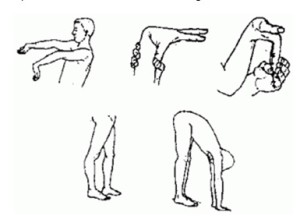 People come in all shapes and sizes but we all (with some exceptions) have the same number of bones, muscles, ligaments and tendons. Ligaments hold our bones together, and muscles and tendons coordinate with the nervous system to move the bones. It is the relative tension found in these connective elements that determines how our joints will be able to function. Even though we all have the same parts we don’t all function the same way.
People come in all shapes and sizes but we all (with some exceptions) have the same number of bones, muscles, ligaments and tendons. Ligaments hold our bones together, and muscles and tendons coordinate with the nervous system to move the bones. It is the relative tension found in these connective elements that determines how our joints will be able to function. Even though we all have the same parts we don’t all function the same way.
There are a number of different types of joints in the body; some with more give than others. The hinge joint of the knee is designed for very little movement while the hip-joint is meant to move freely. Gliding joints have movement in one plane but not others. If you take the muscles, ligaments and tendons out of the equation the joints would move exactly as described.
All muscles have an ideal resting tone and work in pairs that hope to be balanced. Long fluid muscles with the correct tone in opposing muscles (and ligaments that cooperate) will allow for open and loose joints. The opposite is true for tight muscles. If the muscles surrounding a joint are tight and lack any room to stretch the affected joint will by necessity be limited in its range of motion.
Ligaments, which connect bone to bone, can have different qualities in different people. Ligaments are meant to have very little capacity to stretch. But not everyone’s ligaments provide the requisite tension. Many people simply have looser ligaments than others and as a result can have too much movement available between the bones.
A natural and positive example of this is the lax ligaments of pregnant women. When a woman gets pregnant hormones are released so the ligaments can loosen and the pelvis can open for a baby to pass through a too small space.
As you start to look at a lot of bodies it can make you crazy to see all these different patterns in people. You can have loose ligaments with tight muscles, loose ligaments with too loose muscles, loose ligaments with well-toned muscles, good ligaments with tight muscles, and good ligaments with loose muscles. Whoa!
This can make my job very difficult and make someone who falls into one of these patterns very depressed.
I have to say that every once in a while I come across students who have it all together—well toned and balanced muscles as well as ligaments with proper strength and tension. These people are few and far between and I have to admit that they annoy me and I am a little jealous.
Without going on forever I will write about one of these patterns—one that I see quite often—loose ligaments with well-toned muscles.
There are great many people who suffer from pain due to both weakness in muscle and laxity in the ligaments. At some point a doctor or physical therapist might have told them that they need to get strong to stay out of pain. And while that is true it isn’t always the answer. Let’s say Debbie goes to the doctor who tells her to get strong to support her body and Debbie goes out and does that—finding a personal trainer and a yoga class that she loves. In six months or a year Debbie is looking and feeling really good about life and has even been relatively pain-free.
But then she is in a yoga class and she moves in a certain way and her sacrum slips out of alignment. Debbie has gotten much stronger in her muscles since taking on the exercise routine but the tensile strength of the ligaments hasn’t changed and they are still susceptible to injury.
This can drive someone mad if they have done what was asked of them and still have not found relief. The bummer is that I don’t have much to offer Debbie. There are modalities and supplements that work on improving tension in ligaments but I don’t know a lot of people who have had success down this road. For someone like Debbie, constant awareness is the only answer to her body’s troubles. Someone with loose ligaments like Debbie has to work her body differently than others. The emphasis while stretching the muscles has to be on not stretching the ligaments at the same time. Or it needs to be on stretching the muscles while trying to figure out how to keep the bones from moving. Needless to say this is easier said that done.
This is one of the reasons why group classes can be hard for people to take. No one should only listen to a teacher outside, they need to cultivate the teacher inside in order to listen to their bodies and cultivate an understanding of what is going on within.
***
